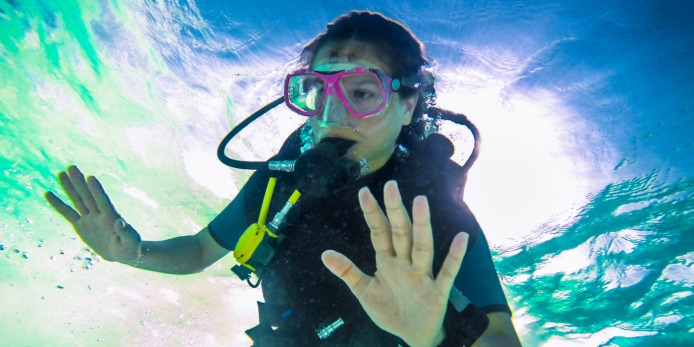By Juanita Pienaar/ scuba diver life
Diving is fun, adventurous, often exhilarating and often meditative. But there’s a darker side of diving as well, which we often gloss over with phrases like “in the unlikely event,” and “Stop. Breathe. Think. Act.” During my diving career I have experienced everything from a slight anxiety to full-on panic episodes. As an instructor, I have seen students and fun divers in similar situations. While some people can bring themselves back from the edge, others escalate to a full panic experience. I remember some of my very first dives, when I was right on the edge of panic but unable to speak out about it because of how I thought others would perceive me. So let’s talk a little bit about a scuba-related panic episode and what you can do to bring yourself back from the brink.
In 2003, the Undersea Journal published research by David and Lynn Colvard on panic among recreational scuba divers. The study states that researchers think that a panicked response to stress plays a large role in dive fatalities. Alfred Bove, author of Medical Examination of Sport Scuba Divers, echoes this sentiment: “panic, or ineffective behavior in the emergency situation when fear is present, is the single biggest killer of sport divers.” Unfortunately, we cannot know this for sure, but what do we know about panic and diving?
What does the research say?
The Recreational Scuba Training Council’s (RSTC) 1998 guidelines for the recreational scuba diver’s physical examination listed ‘a history of panic disorder’ as a no-go zone for divers. This means that individuals with a history of panic disorder were deemed medically unfit to dive. In 2001, the guidelines changed to include a ‘history of untreated panic disorder’ as a high-risk condition for diving, but also acknowledged that with treatment, such conditions pose a lower risk to diving activities.
What causes panic attacks?
First, we need to define a panic attack. For their research, the Colvards defined it as “an intense fear of losing control or dying.” They linked this to the definition of a panic attack found in the 5th edition of the Diagnostic and Statistical Manual (DSM) of Mental Disorders, which defines an attack as “a discrete period of intense fear or discomfort that is accompanied by at least four of 13 somatic or cognitive symptoms…often accompanied by a sense of imminent danger or impending doom and an urge to escape…or desire to flee from wherever the attack is occurring.”
For divers this could turn into an uncontrolled ascent or other kind of flight response. The Colvards found that 15 percent of divers who experience their first panic while diving engaged in a rapid or uncontrolled ascent. While this number seems relatively low, it is based on a survey of current divers. To date there is no information on how many divers stopped diving due to experiencing panic. We also cannot establish how many diving fatalities panic has caused. Investigators often label these cases as drowning deaths, with little information on the events leading up to the incident.
Who is at risk?
Women, and especially women who have a history of panic attacks, tend to experience more panic attacks than men. On the other hand, the men who participated in the Colvards’ research viewed their first panic during a dive as life-threatening. They also found that women tend to accept help more often than men and attribute this to the possibility that in many cultures men are conditioned to be self-reliant.
People who have a history of panic attacks above water are about twice as likely to panic while diving as those who have never experienced a panic attack before. They are also more likely to have more than one panic experience while diving.
Triggers are unique to every individual. We do know that it is not dependent on when you last dived or on your certification level.
How can you address scuba-related panic?
Happily, the Colvards found that most divers who had experienced a panic episode while diving remembered and used their training on how to deal with the situation. They also found that most divers who experienced a panic situation while diving went for additional training afterwards.
Panic happens when an individual does not have any solutions for a serious problem. The quality of training will help provide divers the skills they need in these situations. Repeating and practicing skills to become familiar with them can change the way a diver reacts in a panic situation as well. Furthermore, by continuing their education, divers increase their available skills, which they can rely on if they do feel panicky.
How to recognize a panic attack
A panic is a distinct episode of fear and discomfort with four or more of the following symptoms present. They develop quickly and peak in about 10 minutes:
- palpitations, pounding heart, or accelerated heart rate
- sweating
- trembling or shaking
- sensations of shortness of breath or smothering
- feeling of choking
- chest pain or discomfort
- nausea or abdominal distress
- feeling dizzy, unsteady, lightheaded or faint
- derealization (feelings of unreality) or depersonalization (being detached from oneself)
- fear of losing control or going crazy
- fear of dying
- paresthesias (numbness or tingling sensations)
- chills or hot flashes










